
Título/Grado
Ingeniero Civil Ambiental, UFRO
Contacto
j.nanculeo01@ufromail.cl
Profesor(a) Guía
Dra. María Eugenia González
Financiamiento
Doctorado Nacional, ANID
Título de tesis
Development of a bifunctional electrocatalyst based on Mo-Co-Ni supported onto biochar derived from hazelnut shells, for the production of green H2.
Currently, several countries have shown great interest in diversifying their energy matrix an alternative fuel of great interest worldwide at present is green H2 produced by electrolysis. The main advantages of this fuel are its high calorific value and the fact that it is a clean fuel. However, the high energy demand involved in H2O splitting and the high cost of noble metal-based electrodes are the main challenge to overcome. In view of this, the development of electrocatalysts based on non-noble metals (or noble metal- free) supported onto carbonaceous complexes (graphene and carbon nanotubes) have generated great interest, in order to obtain a competitively low overpotential, using cheaper raw materials. However, the high cost associated with these supports are a major limitation, opening the opportunity to use supports with similar characteristics to graphene and carbon nanotubes at a lower cost, and ideally, that can be used as cathode (catalyze HER) and anode (catalyze OER), i.e., bifunctional. An alternative is biochar produced by pyrolysis of agro-industrial wastes, because of its documented high surface area, good stability and conductivity. Based on the above, the general goal of this project is to develop a Mo-Co-Ni/biochar-based bifunctional electrocatalysts, produced by the pyrolysis of residual hazelnut shells, for the production of green H2. To address this, a three-factor experimental design (pyrolysis temperature, residence time and biochar: catalyst ratio) with three levels will be executed to evaluate the significance of these factors on the surface area, electrical conductivity and overpotential of the catalysts. The expected results will be to produce biochar with ideal characteristics to be used as a electrocatalysts support by slow pyrolysis. It is also expected that the activation with KOH and N-doping will be more effective by impregnating the biomass before pyrolysis. Finally, the electrocatalyst is expected to have a competitive performance compared to those noble-metals-based in the electrolysis of acid, alkaline and wastewater matrices, extending the versatility of H2 production.

Título/Grado
Ingeniero Civil Ambiental, UCT
Magister en Ciencias de la Ingeniería mención Biotecnología
Magister en Gestión de Negocios
Contacto
m.araneda07@ufromail.cl
Profesor(a) Guía
Dr. Gustavo Ciudad
Financiamiento
Doctorado Nacional, ANID
Título de tesis
Develop of a biorefinery process based on the use of Olive Mill Solid Waste (OMSW) pretreated with White-rot Fungi (WRF) and Aquaculture Sludge (AS) supplements
Olive Mill Solid Waste (OMSW) is one of the most polluting wastes from the food industry due to its recalcitrant characteristics but is a good candidate for biogas and biofertilizer production due has a high organic matter content. OMSW pretreatment is necessary to eliminate the phenolic compound in order to avoid the microbial inhibition in biological treatments. In this sense, biological pretreatments using white-rot fungi (WRF) to degrade the OMSW has been gaining attention due it low economic and environmental cost. But, the low nitrogen content in the OMSW could limits the ligninolytic enzymatic activity of WRF. So, the addition of an external nitrogen source to the OMSW could improve the fungi ligninolytic activity. In this context, the aquaculture industry waste has high nitrogen content and frequently are disposal in sanitary landfills. The AS could be used as OMSW cosubstrate to improve their pretreatment processes by WRF. The study proposal is based on developing an economically and environmentally viable biorefinery process from the pretreatment of OMSW with WRF supplemented with Aquaculture Sludge (AS) as a nitrogen source, to obtain value-added compounds. The enzymatic extract will be obtained in the liquid phase of the pretreatment process, the solid phase obtained from the pretreatment will be subjected to codigestion with supplemental addition of nitrogen by means of AS, to evaluate the performance in biogas production. The economic study will be carried out by means of economic indicators of projects and the environmental study will be carried out by means of the Life Cycle Assessment (LCA) methodology, using Simapro software.

Título/Grado
Químico, Universidad de Los Andes (ULA), Venezuela
Magíster en Ingeniería Química, Universidad Federal de Santa María, Brasil
Contacto
j.vera12@ufromail.cl
Profesor(a) Guía
Prof. Guía: Dra. Olga Rubilar
Prof. Co-Guía: Dr. Gonzalo Tortella
Financiamiento
Doctorado Nacional, ANID
Título de tesis
Biogenic synthesis of Fe3O4@SiO2@ZnO nanoparticles for depolymerization of Kraft lignin in a photoreactor: Photocatalytic activity, recycling and obtaining high value added phenolic compounds
Conversion of residual lignin into chemically valuable products through environmentally friendly processes at mild reaction conditions is one of the challenges facing the still emerging bioeconomy. In this scenery, heterogeneous photocatalytic processes for lignin valorization stand out due to its potential to provide a cleaner and more sustainable alternative. Superparamagnetic Fe3O4@SiO2@ZnO nanoparticles synthesized by using natural resources could be an efficient photocatalyst for lignin depolymerization. The use of a simple and eco-friendly route for the synthesis of magnetic nanocomposites based on ZnO could minimize the use of toxic reagents and solvents. The aim of this proposal thesis is to evaluate the biogenic synthesis and reuse of Fe3O4@SiO2@ZnO nanoparticles in the depolymerization of lignin Kraft in a photoreactor to obtain vanillin, vanillic acid, syringaldehyde, and guaiacol as value-added products. For the synthesis of the nanoparticles, the wheat straw will be used as SiO2 biosource, while that aqueous extract of the leaves of Galega officinalis will be used as reducing and stabilizing agents for the synthesis of Fe3O4 and ZnO.
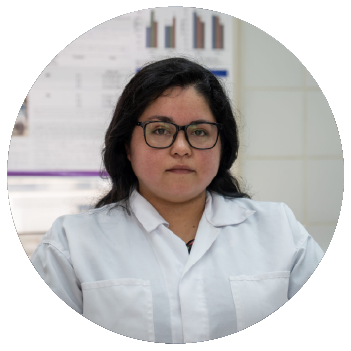
Título/Grado
Ing. Civil en Biotecnología, UFRO
Contacto
c.marillan01@ufromail.cl
Profesor(a) Guía
Dr. Edgar Uquiche
Financiamiento
Doctorado Nacional, ANID
Título de tesis
Evaluation of sequential supercritical extraction to obtain fractions from Leptocarpha rivularis extracts and their use as cholinesterase inhibitors
Alzheimer’s is a progressive neurodegenerative disease that leads to the loss of memory and autonomy of who suffer from it. Inhibition of cholinesterase enzymes have been reported to be a viable therapeutic target for the treatment of Alzheimer’s. This treatment is based on the use of cholinesterase inhibitors, which helps to delay the degradation of acetylcholine. Cholinesterase inhibitors are drugs of a non-selective nature that can cause nausea, vomiting, diarrhea, among others. However, the inhibition of cholinesterase remains an important objective for the decrease in the progression of Alzheimer’s. A promising approach to treating Alzheimer’s disease is the use of medicinal plants. Leptocarpha rivularis is a plant whose therapeutic properties have been studied for the treatment of various diseases, due to its important content of bioactive compounds. Obtaining these compounds from the plant can be carry out by supercritical extraction with CO2. Supercritical CO2 can extract non-polar bioactive compounds. Extraction of more polar compounds requires the addition of a cosolvent such as ethanol. Depending on the extraction conditions it is possible to carry out fractional or sequential extraction. Sequential supercritical extraction has the advantage of achieving fractionation and a higher extraction yield due to a greater exhaustion of the substrate. The objective of the research proposal will be to evaluate sequential supercritical extraction as an extraction method to obtain enriched fractions of bioactive compounds from L. rivularis stems and their application as inhibitors of cholinesterase enzymes. It is expected to obtain extract fractions with a high cholinesterase enzyme inhibition capacity, characterized by their higher concentration of bioactive compounds compared to supercritical one-stage extraction.

Título/Grado
Ingeniería en Alimentos
Contacto
liset.flores@ufrontera.cl
Profesor(a) Guía
Dra. Carolina Shene
Financiamiento
Doctorado Nacional, ANID
Título de tesis
Production of coenzyme Q10 (CoQ10) by a native strain of thraustochytrid: optimization of process conditions
Coenzyme Q10 (CoQ10) is a cofactor of the electron transfer process in the plasma membrane of prokaryotes and the inner mitochondrial membrane of eukaryotes. The molecule consists of a quinone coupled to an isoprenoid chain composed of 10 sequentially linked isoprenyl groups. This coenzyme has also antioxidant activity, a property that has been used to counteract the effects of many diseases such as hypertension, Alzheimer’s, Parkinson’s, heart diseases, among others. Because it is a powerful anti-aging factor it is commonly added in the preparation of facial and body creams. CoQ10 can also be found as part of dietary supplements. Thraustochytrids are marine protists known mainly because of their ability to accumulate lipids rich in long-chain omega-3 polyunsaturated fatty acids at high levels. Previous studies have established that at least one isolated native strain, called RT2316-13, possesses all the genes involved in the synthesis of CoQ10. The general objective of this project is to determine culture conditions and parameters for the CoQ10 production process using the RT2316-13 strain, one of the hypotheses of this work that the microbial CoQ10 production could be economically feasible if the valorization of different biomass fractions is considered.

Título/Grado
Ing. Civil en Biotecnología, UFRO
Contacto
d.valdebenito01@ufromail.cl
Profesor(a) Guía
Dra. Carolina Shene
Financiamiento
Doctorado Nacional, ANID
Título de tesis
Production of phospholipids in Thraustochytrium sp.: effect of culture and extraction conditions
Numerous are the positive effects of long-chain omega-3 polyunsaturated fatty acids (LC PUFAs). Human activity has transformed the marine environment increasing the concentration of pollutants that affect the quality of these products, for this reason it is necessary to look for alternative sources with potential to be used at the industrial level. Thraustochytrids have been extensively studied for the production of ω-3 LC PUFAs in the form of triacylglycerols (TAG) or neutral lipids, in these microorganisms it is also possible to find DHA. However, its production and yield would be affected by culture conditions. The conventional method of microbial lipid extraction has been solvent extraction. At industrial scale, hexane is used as a solvent due to its high efficiency and easy recovery by evaporation. However, its repercussions on the environment and toxicity have forced to look for new alternatives. Green solvent technologies, such as supercritical carbon dioxide (SC-CO2) extraction, aim to develop non-toxic and environmentally friendly extraction processes. The objectives of this research is the study of the effect of the composition of the medium and culture condition on the ω-3 LC-PUFAs production linked to phospholipids by Thraustochytrium sp, and is to define the conditions of the SC-CO2 extraction process of these compounds by adding ethanol as a modifier agent.

Título/Grado
Ing. Civil Electrónico, UFRO
Magíster en Ciencias de la Ingeniería mención Ing. Eléctrica, UFRO
Contacto
e.werner01@ufromail.cl
Profesor(a) Guía
Dra. Mónica Rubilar
Financiamiento
Doctorado Nacional, ANID
Título de tesis
Formulation and cooling stage, key factors in the elaboration of canola oil oleogels as fat substitutes, with solid texture characteristics and stable to lipid oxidation, applicable to the food industry
Due to the damage to health from consumption of high levels of saturated fatty acids (SFA) and trans-fatty acids (TFA), there has been an increased interest in polyunsaturated fatty acids (PUFA) consumption from plant sources. This has made necessary to study alternatives that supply fats with a healthy lipid profile. Oleogelation is a technique that has been developed to structure liquid edible oil into a product called oleogel to be used as a food ingredient with a solid texture, giving the possibility to elaborate a fat system without TFA and/or with lower amounts of SFA. Oleogelation “traps” the liquid oil in a three-dimensional network using structuring molecules within beeswax and ethyl cellulose have been successfully used. Studies have shown the influence of internal factors and external factors on the final characteristics of the oleogel. In this area, the cooling stage, a crucial factor for obtaining the desired final oleogel characteristics have been poorly studied. Considering this, this work aims to evaluate the formulation (concentration and oleogelator type) and cooling stage in the oleogel elaboration to obtain oleogels based on canola oil with a solid texture and stable against lipid oxidation. An experimental cooling system will be designed, capable of applying a controlled cooling temperature profile, avoiding external temperature disturbances.
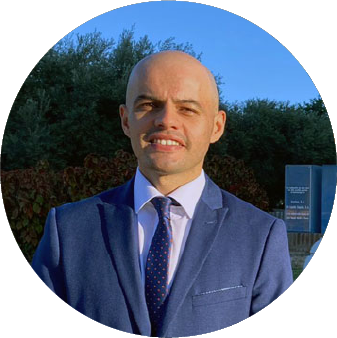
Título/Grado
Ingeniero en Biotecnología Marina y Acuicultura, Universidad de Concepción
Magíster en Ciencias mención Botánica, Universidad de Concepción
Contacto
p.castro07@ufromail.cl
Profesor(a) Guía
Dra. Mónica Rubilar
Financiamiento
Doctorado Nacional, ANID
Título de tesis
Development of a food ingredient based on microencapsulated R- phycoerythrin pigment from macroalgae Gigartina skottsbergii (Rhodophyta)
Publicaciones
The global demand for natural colorants is growing in the food industry, to date, the only red pigment of natural origin is obtained from an insect, the carmine (cochineal extract). Macroalgae are currently used extensively in the pharmaceutical, cosmetics and food industries. In Chile. The initiative of this work is to develop specialized microencapsulated additives, containing phycoerythrin, a phycobilinic pigment that accumulate the red-color of macroalgae, which is hydrophilic and protein-based with proven antioxidant activity. The technological development focuses on determine the influence of the hydrolysis factors, in addition to separation techniques (ultrafiltration) that allow to ensure and reproduce an optimal phycoerythrin extraction process through the response surface methodology. The technological development is expected to be incorporated into the model of biorefinery algal process at the Chilean company Gelymar S.A. (Puerto Montt, Chile), as an experimental strategy to recover the pigment prior to extractive stages of carregenin, an ingredient with emulsifying properties used in the cosmetics and food industry. Finally, it is expected to have an innovative and sustainable optimal technology, oriented to the development of new healthy ingredients, suitable for human consumption.

Título/Grado
Ing. Civil Electrónico, UFRO
Magíster en Ciencias de la Ingeniería mención Ing. Eléctrica, UFRO
Contacto
claudio.alarcon@uct.cl
Profesor(a) Guía
Dra. Carolina Shene
Financiamiento
Doctorado Nacional, ANID
Título de tesis
Design and implementation of a biomass growth-rate control strategy for the fed-batch culturing of Thraustochytrids.
Publicaciones
Thraustochytrids are the primary source of long-chain omega-3 fatty acids that lead to their accumulation in marine organisms. Thraustochytrids have been successfully used in the biotechnological production of EPA/DHA-rich lipids at the industrial scale. Operational conditions need to be defined based on the target product. The feeding rate needs to be controlled during the culture process. In general, for oleaginous microorganism cell growth and lipid accumulation do not occur simultaneously. For this reason, the specific growth rate could be suggested as the variable to be controlled in the fed-batch culturing of thraustochytrids. Nevertheless, the specific set points have to be determined. The specific growth-rate is a response of the cells to the culture conditions and can be used to monitor the effect of the substrates supplied. The specific problem addressed by this research proposal is nonexistence of real-time growth-rate sensors and controllers for the biomass growth-rate. The proposed solution to the problem presented above is to design a growth-rate softsensor for the subsequent design of a growth rate controller. The softsensor for the specific growth-rate will consist of an actuator over the oxygen supply and a dissolved oxygen sensor. Parameters of the softsensor will be fitted using experimental tests. The results obtained will be validated with the experimentally measured biomass concentration. In a monitored culture, after the first turn-off-turn-on test, for every test, a value of the specific growth-rate will be obtained. For the second objective, the manipulated variable will be the feeding rate. The controller will be designed and tested as a P, PI, or Predictive controller. The best controller will be selected with the criteria of absolute error value over time.
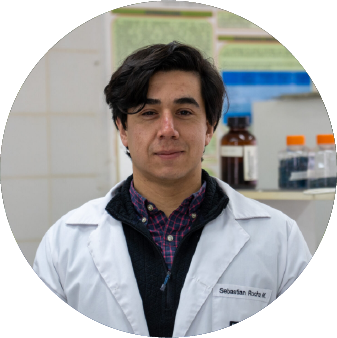
Título/Grado
Ing. Civil en Biotecnología, UFRO
Contacto
s.rocha01@ufromail.cl
Profesor(a) Guía
Dra. Mara Cea
Financiamiento
Doctorado Nacional, ANID
Título de tesis
Evaluation of 5-hydroxymethylfurfural synthesis in sugar beet molasses by microwave-assisted hydrothermal treatment and its use as raw material for biosynthesis of 2,5-furandicarboxylic acid by bacterial activity.
Publicaciones
One of the main side streams of sugar industry is molasses, whose high content of sugars and high availability make it suitable for the synthesis of 5-hydroxymethylfurfural (HMF). In recent years, more sustainable technologies for thermal processing of carbohydrate-rich biomass have been proposed, like microwave-assisted hydrothermal treatment. On the other hand, 2,5- furandicarboxylic acid (FDCA), a derivative of HMF, is a chemical considered key to the development of a sustainable future given its potential as a replacement for terephthalic acid in polyethylene terephthalate (PET) production. However, analogous to HMF, the conventional synthesis of FDCA requires the use of high temperatures, pressure and methodologies that usually require contaminating compounds. This leads us to look for new methods of synthesis of FDCA that require less energy and are sustainable. This work aims to evaluate the synthesis of 5-hydroxymethylfurfural in sugar beet molasses by microwave-assisted hydrothermally treatment and its use as raw material for biosynthesis of 2,5-furandicarboxylic acid by bacterial activity. To achieve this, residual molasses from the national sugar industry (IANSA) will be used so that the sugars are dehydrated and the molasses is enriched in HMF. After previous conditioning, use the hydrothermally treated molasses as part of the culture medium of C. basilensis in batch regime and that, through bacterial activity, the HMF dissolved in the medium is transformed into FDCA. In addition, it will be studied how the composition of this by-product affects the kinetics of dehydration of sugars to HMF.

Título/Grado
Ing. Civil Ambiental, UCT
Magíster en Ciencias de la Ingeniería mención Biotecnología, UFRO
Doctora en Ciencias de la Ingeniería mención Bioprocesos
Contacto
fernanda.pinto@ufrontera.cl
Profesor(a) Guía
Prof. Guía: Dra. Mara Cea
Prof. Co-Guía: Dr. Gustavo Ciudad
Financiamiento
Doctorado Nacional, CONICYT
Título de tesis
Biological co-production of levulinic and adipic acid with polyhydroxyalkanoates by using mixed microbial cultures fed with synthetic hemicellulose hydrolysate.
Lignocellulosic compounds use involves the biomass fractionation into their respective components; Lignin, cellulosa and hemicellulose. In most cases only glucose is used. A lignocellulosic biorefinery, where all components of this biomass are harnessed, is a good opportunity for the use of this resource. Pentoses are the mainly component of hemicellulose, which could be used as food for microorganisms that produce polyhydroxyalkanoates (PHAs), hydrocarbons that could replace petrochemical plastics since have similars characteristics. PHAs are accumulated by many microorganisms as a energy source. PHA accumulation is produced, if microorganisms are under stres condition. The use of sequential batch reactors (SBR) has been used to obtain PHA producer microorganisms. This work proposes the study of hemicellulose rich effluents as food for PHA accumulator microorganisms obtained from wastewater treatment plants.
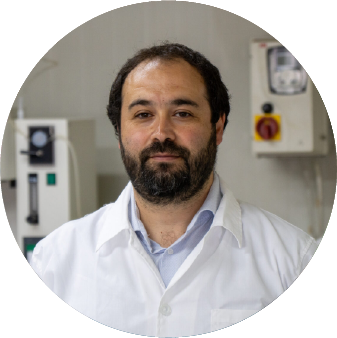
Título/Grado
Ing. Alimentos, UFRO
Magíster en Ciencias de la Ingeniería mención Biotecnología, UFRO
Doctor en Ciencias de la Ingeniería mención Bioprocesos
Contacto
eduardo.morales@ufrontera.cl
Profesor(a) Guía
Dra. Mónica Rubilar
Financiamiento
Tesis en el sector productivo, CONICYT
Título de tesis
Development of oil-in-water multilayer emulsion as an effective encapsulation systems of astaxanthin
Publicaciones
The applications of astaxanthin in different food formulations are limited due to its poor water solubility, susceptibility to oxidants, light and heat, resulting in poor quality products with reduced health promoting properties. Therefore, the free astaxanthin requires carriers and forms of protection from chemical damage or modification, before it can be used in functional foods. Multilayer emulsions seem to be much more advantageous and promising to develop encapsulation and delivery system of bioactive lipophilic compounds, compared with conventional emulsions, during spray-drying process. Consequently, the main purpose of the study is to develop a powder O/W multilayer emulsions as an effective encapsulation systems of astaxanthin to use as a functional ingredient for formulating a food beverage. The results obtained from this research proposal will provide a better understanding of food beverage applications of the powder ingredient based on astaxanthin enriched multilayer emulsion stabilized by ionic biopolymers.
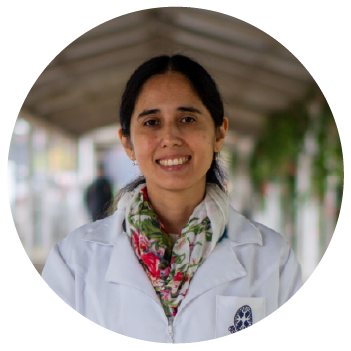
Título/Grado
Ing. Civil Industrial mención Bioprocesos, UFRO
Magíster en Ciencias de la Ingeniería mención Biotecnología, UFRO
Doctora en Ciencias de la Ingeniería mención Bioprocesos
Contacto
carla.duarte@ufrontera.cl
Profesor(a) Guía
Dr. Gustavo Ciudad
Financiamiento
Tesis en el sector productivo, CONICYT
Título de tesis
Precipitation of copper from mining wastewater through microbial induced carbonate precipitation (MICP) process
Publicaciones
Mining activities generate a series of metal containing wastes that if not handled properly, can represent a serious environmental risk. One of those risks is heavy metal pollution of soil and water. During the last years, biological processes have been proposed and developed for heavy metals removal.
MICP is a biological process that may represent an alternative for metal precipitation. It uses ureolytic pathway: bacteria catalyses urea hydrolysis into carbonate and ammonium, leading to the alkalinisation of the environment, favouring the binding of calcium and carbonate, and further calcite precipitation. When heavy metals are present, a competitive precipitation occurs between this heavy metals and Ca2+, enabling carbonate metals recovery from wastewater. The MICP process has a double beneficial effect, since not only wastewater is remediated by the removal of the metals, but also these metals are effectively sequestered as mineral precipitates for long periods. Several factors govern MICP process, such as bacteria type, pH, temperature, urea and Ca2+ concentrations, and nucleation sites. Several microorganisms presenting high levels of urease activity have been identified, such as Sporosarcina pasteurii, an some of them have been isolated from contaminated soils in mining areas, and present resistance to heavy metals. The goal of this thesis is to evaluate the technological feasibility of MICP process for bio-precipitation of heavy metals from mining wastewaters. For that purpose, several microbial strains with ureolytic capacity will be studied.